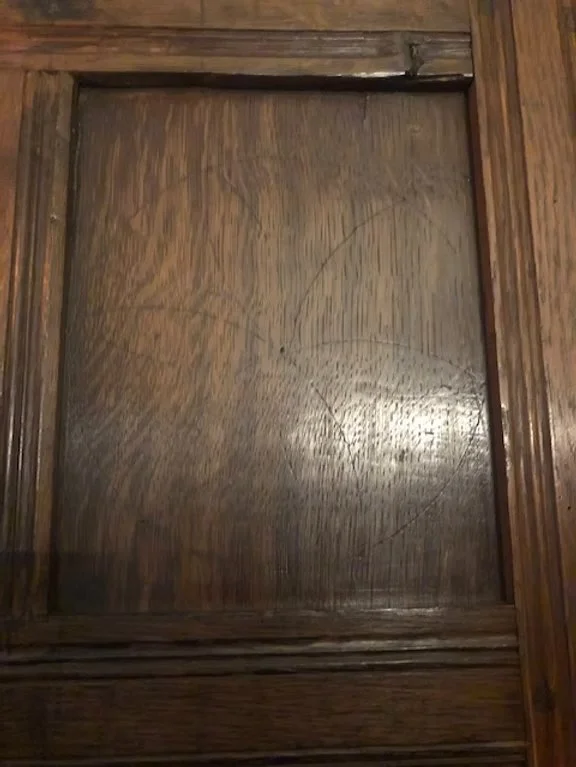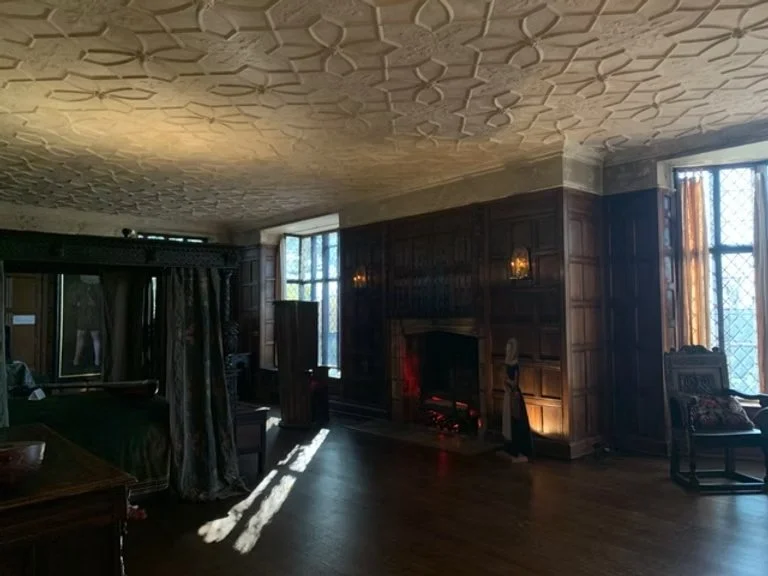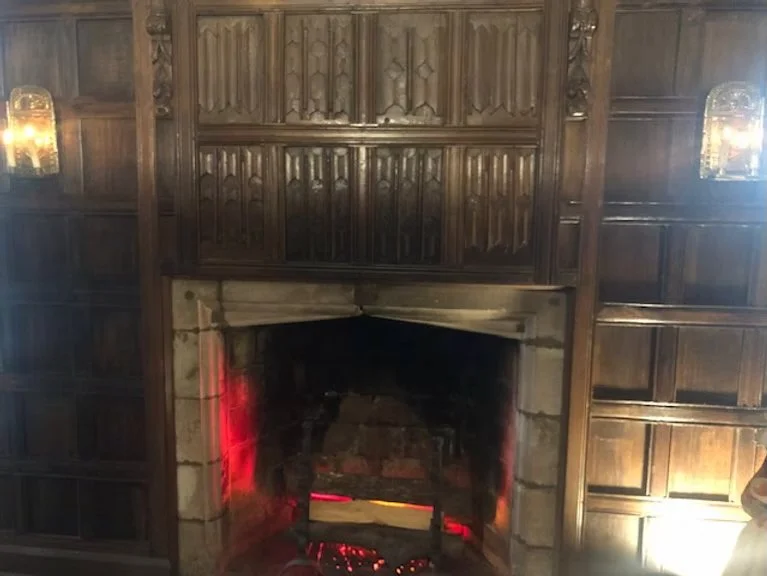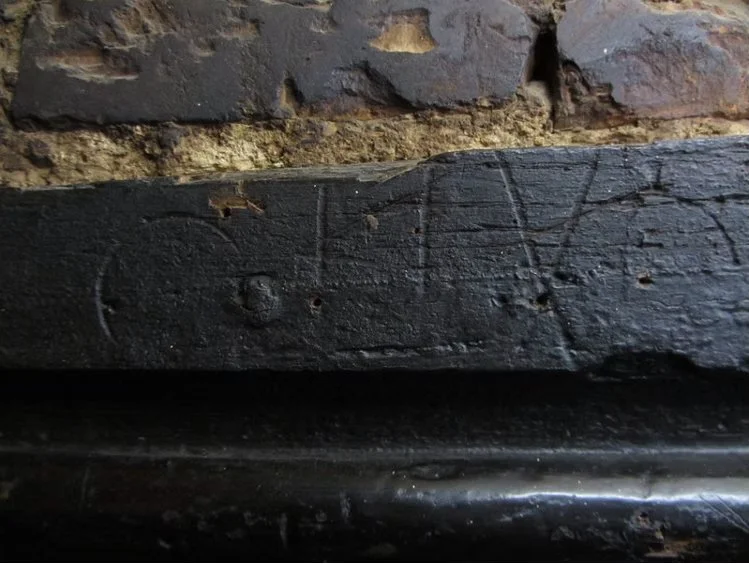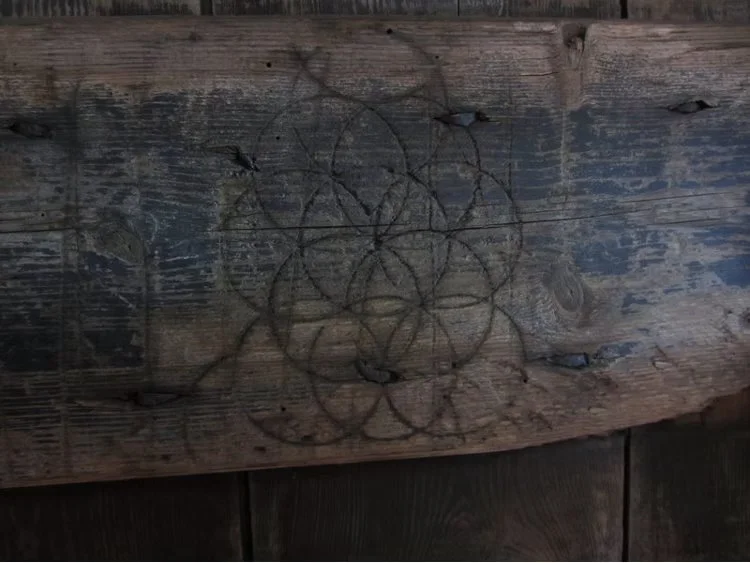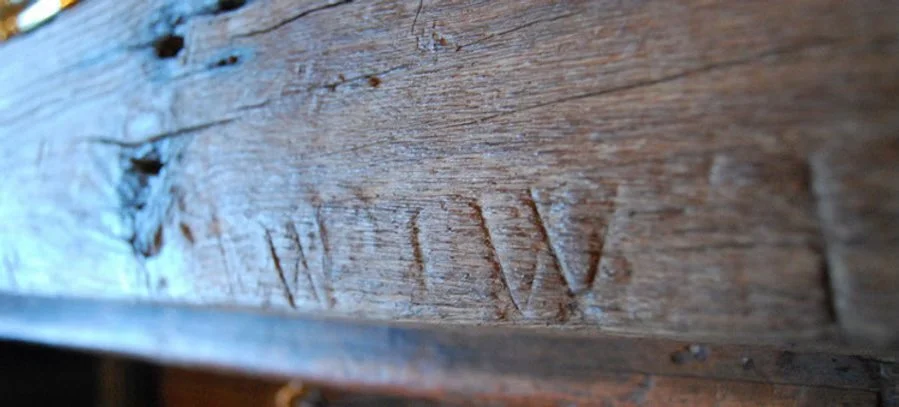Apotropaic Mark
Dr. Ian Tyers, a dedrochronologist from England, was here in 2016, inspecting and dating our wood panel paintings. While looking at our large panel portrait of George Poulet (1593), located in our Great Parlor, Dr. Tyers found something very neat! If you stand facing the fireplace and look at the fifth square up from the floor on the left-hand side of the fireplace, you will see a lightly inscribed daisy wheel (above), an apotropaic mark. This long forgotten mark was hiding in plain sight for centuries until Dr. Tyers brought it to the staff’s attention.
An apotropaic mark (also known as a witch mark, a hexfoil, or a charm) was thought to have the power to keep away evil spirits, witches, or just plain bad luck. The same marks have been found in homes throughout England and date mainly from the mid-1500s to the mid-1700s, “a period in which there was continued and widespread belief in witchcraft, when people felt the need to resort to protective magic.”[1] At this time, even though most everyone in the country was a professed Christian, most everyone also believed in evil spirits. Today, we can easily explain many things with science, but in the seventeenth century, many scientific discoveries had yet to be made and many people were dying or getting sick seemingly out of nowhere—evil spirits, witches, sprites, and their ilk had to be to blame! King James I (1603-1625) wrote an essay called Daemonologie, In Forme of a Dialogue, Divided into three Books: By the High and Mighty Prince, James &c. (1599) discussing witchcraft and sorcery and how canonical law provides rules for persecuting witches.
Frequently small, faint, and hard to see, apotropaic marks are usually found where there is an opening through which evil could easily enter—doors, windows, and fireplaces. A mantle, whether stone or wood, was a very common spot to place an apotropaic mark, and, oftentimes, there would be quite a few over lapping marks. Fireplaces were a known weak spot in home defense because “it was thought that…doors barred and windows shuttered…[but] that the chimney, open to the sky, was vulnerable—particularly for incursions of evil.”[2] In Agecroft’s case, the apotropaic mark has been strengthened by the addition of scorch marks which are thought to have been made before the mantle was installed to protect the house and its inhabitants from both house fires and witches. The intent of the scorch marks was to fight hellfire with fire.
Our daisy wheel symbol is among the most common marks found. Made with a compass, the wheels vary in the number of ‘petals’ they have. Other marks include a double ‘V’ representing ‘virgo virginum, (Does that reference the Virgin Mary, the virgin among virgins?)’ a ‘P’ intertwined with a cross, a ‘W’ intertwined with a ‘P,’ and the St. Andrew’s cross, as St. Andrew was considered the best hex against witches.[3] A much more uncommon type of marking is the demon trap: “maze like markings intended to trap the malevolent spirits which followed the lines and were unable to find their way back out.”[4]
While the markings are generally scratched into the wood or stone surrounding an opening, some have been found painted on plaster, carved on to wood furniture, and embroidered on textiles.[5] Hexfoils have also been found marked on the underside of floorboards near doors, windows, and fireplaces.
This excellent find at Agecroft Hall leads to two questions: was the daisy wheel reinstalled beside the fireplace in the rebuilt Agecroft Hall on purpose, or was it just a happy accident? Are there more apotropaic marks to be found in the plethora of paneling at Agecroft Hall? While the first question may never be answered, it is still a fun hypothetical to think through. The answer to the second question is yes! Other hexfoils have since been found—look closely around the fireplaces in the downstairs rooms. Come see the daisy wheel for yourself and take a closer look at the wood paneling—perhaps you’ll discover another, centuries-old, protective mark at Agecroft Hall!
[1] Binding, C.J. and L.J. Wilson, “Ritual Protection Marks in Wookey Hole and Long Hole, Somerset.” 2010.
[2] Reeve, Anthony. “Here be withcraft.” Lassco.www.lassco.co.uk/lassco-news/2013/10/29/here-be-witchcraft/ 29 October 2013. Accessed 20 May 2016.
[3] Reeve.
[4] Kennedy, Maev. “Witch marks fit for a king beguile archaelogists at Knole.” The Guardian. 4 November 2014. Accessed 20 May 2016.
[5] “Guarding the Lintels.” www.winslowhouse.org/guarding-the-lintels/ 29 October 2014. Accessed 20 May 2016

